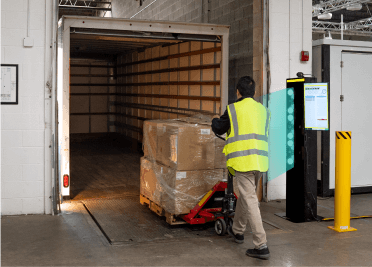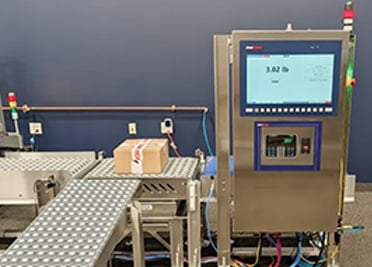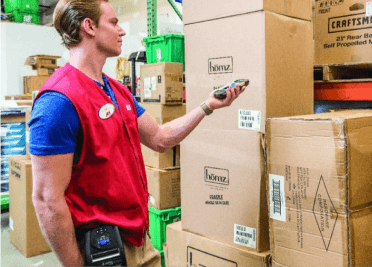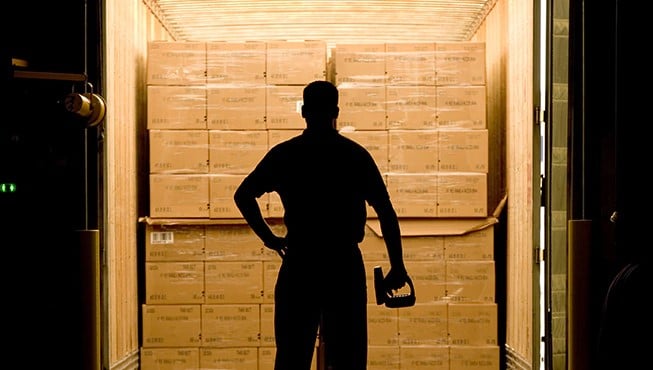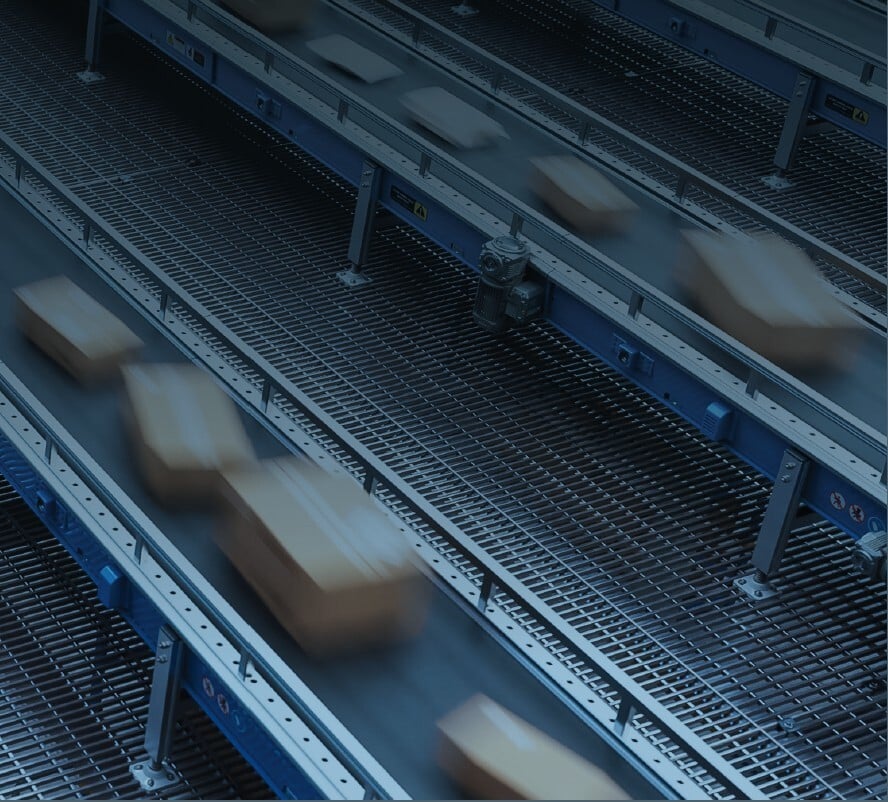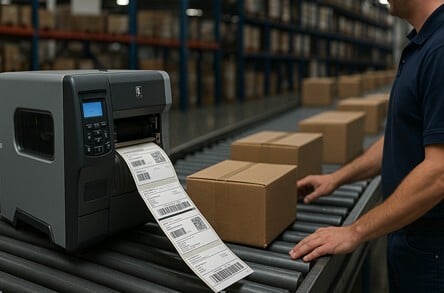It can be argued that the receiving process is the most important process in the DC. All downstream processing depends on the accuracies and efficiencies achieved in the receiving process. Receiving quantity and/or product errors will ultimately affect the ability to ship the right product and the right quantity to customers, resulting in decreased customer satisfaction levels and possible sales loss to competitors.
The receiving process can be separated into distinct steps that include Unloading and Checking. We will look at each of these processes individually for areas where we can provide improvements in accuracy and efficiency.
Unloading
The unloading process consists of the movement of the received goods from the container (trailer, rail car, or other delivery method) to the dock floor for proper checking. These goods can arrive on the floor of the container or on pallets. How they arrive helps determine what receiving method is deployed.
Floor-loaded goods can either be transferred to pallets for put-away or fluid unloaded to conveyor for transfer to storage or quite possibly conveyed to outbound directly. In the case of fluid unloading, Print and Apply is often utilized to label the merchandise for transit through the automated system. Some common fluid unload operations include office supply clients. In the case of floor-loaded goods transferred to pallets, it is necessary to apply a label that contains pertinent product information to each pallet. This can be a specific label containing both human readable and barcoded information or a generic label containing only a barcode that contains all the information. These cases may also contain RFID tags.
Goods that arrive in LTL, TL, or other methods also go through the unload process. They may or may not have to be broken down into the correct configurations for storage in the DC. This breakdown process is typically done by the driver of the vehicle or lumpers hired by the DC or driver. In some cases the DC staff is responsible for breakdown, but these are not common. These pallets may already contain a label applied by the vendor. This label can be utilized to move the goods through the system. If it does not contain a label, then either a product-specific label or generic label will be applied during the check-in process.
Once the unloading process is started, the check-in process can begin simultaneously if the unloader and checker are separate workers. In some instances they will be the same person.
Checking
The checking process of receiving may be the most critical process in the DC. It is usually performed by senior associates with great knowledge of the DC’s products. The checking process consists of making accurate counts of the product and capturing additional information as outlined above.
Checking can be done in many different ways. There are still many companies using paper-based receiving, which is the most time-consuming and least accurate method. DCs using this method are prime candidates for deploying technology improvements that could include the use of mobile computers, fixed and/or mobile printers, RFID, voice, and MDI.
As part of the checking process, the checker is responsible for verifying that the correct product in the correct quantity in the right condition is being received on the corresponding PO or POs. Capturing this data through scans or voice is more efficient than paper and eliminates the data entry errors associated with writing on a document and subsequently entering that information into a system.
Checkers are responsible for getting the product in a status that allows for either Put-Away or transfer directly to the shipping area if Cross-Dock or Flow-Through is being utilized. This may include applying a product-specific or generic label to the product/pallet, so there is a huge opportunity for media and printers. Some checkers may be responsible for multiple dock doors where stationing fixed printers on the dock in strategic locations can be effective if very large quantities of labels need printed at once. In instances where checkers are responsible for many doors, it is more productive to equip those checkers with mobile printers. The checkers can then apply the correct label to the product/pallet as needed and eliminate unnecessary steps.
Utilizing mobile computers to scan product and label information as well as capture additional data is very productive and accurate. The additional data sometimes captured in receiving was outlined above and assists in providing critical information about the products. It ensures quality control, vendor compliance, and product and consumer safety. Using image capture and MDI can further assist in gathering critical data relevant to quality, damage, load condition, and important document information. In produce or other receiving operations where load condition or inspection is a common process, it is quite possible that image capture with our camera functionality will be relevant.
RFID is also a sound investment for receiving in DCs that have very high volumes, as it can drive high levels of productivity. RFID is also relevant in operations handling high-value items and mixed product cases. RFID is also seeing an increase in the area of container/asset tracking. Replacement costs for returnable containers are usually very high, so deploying technology that allows the operation to keep them in their network typically drives a high ROI.
In DCs using voice technology in the picking process, there may be an interest in expanding the use of voice to other process areas to include receiving. This may also be applicable in DCs not using voice, but wishing to roll out this technology across the entire facility. Although not common for receiving, voice should be considered as a viable technology to deploy.
On the Path to Continuous Improvement
Supply chain leaders who are responsible for DCs continually seek to balance best practices with identifying the most impactful KPIs/metrics to drive productivity, cost optimization, and service excellence.
The real value of metrics comes from analyzing the metrics output and driving a continuous improvement mindset throughout each workflow in the DC/warehouse.
We can point to almost any DC KPI and learn the best-in-class metrics that provide us a benchmark to measure against. The path to best in class is a process of improvement in which you can identify workflow pain points and develop a path that incorporates a combination of investment in technology and continuous improvement.
As a tool to help review and identify opportunities for improvement, DCs conduct what Honeywell refer to as a DC Walkthrough for each workflow, which should be done every two to three years. This is a review/audit based on best practices that can yield clear and measurable actions to use and consider when planning for workflow improvement and investment. We’ll take a closer look later in the article.
According to the WERC study “DC Measures 2018 Trends and Challenges1,” the following are a few of the KPIs that DCs use in part to measure the Receiving workflow:
- Dock-to-Stock Cycle Time, in Hours
- The dock-to-stock cycle time equals the time (typically measured in hours) required to put-away goods. The cycle time begins when goods arrive from the supplier and ends when those goods are put-away in the warehouse and recorded into the inventory management system.
- For a given time period: sum of the cycle time in hours for all supplier receipts / Total number of supplier receipts.
- Quintile performance metrics.
- Best-in-class. < 2 hours
- 6.2
- >= 4 and < 8.096
- >= 8.096 and < 24
- Lines Received and Put-Away per Hour
- Measures the productivity of receiving operations in lines processed and put-away per-person hour.
- Total lines received and put-away / Total person hours worked in the receiving operation.
- Quintile performance metrics.
- Best-in-class. >= 60 per Hour
- 22
- >= 20 and < 27
- >= 8.096 and < 24
- Inventory Count Accuracy by Location
- Indicates that 10 units of part number XYZ are in slot B0029. The inventory count accuracy indicates how frequently one can go to that location and find that the physical count matches the system’s.
- The sum of the number of locations containing an error / The total number of locations counted.
- Quintile performance metrics.
- Best-in-class. >= 99.88%
- 98.40%
- >= 97% and < 99%
- >= 90% and < 97%
Improving the Receiving Workflow with a DC Walkthrough
A DC Walkthrough is an engaging assessment that includes discussions, observations, and interviews among workers, supervisors, and management personnel with the objective to document current business and operational processes and look at ways technology and process changes can be applied to make improvements. The DC Walkthrough can be an informal or formal review/audit conducted by our Solution Experts.
At AbeTech we have the opportunity to conduct DC Walkthroughs throughout the world for every conceivable type and size of DC. The goal of our assessment is to validate logistical/operational processes relative to industry best practices focused on time savings, increased worker productivity, and improved accuracy. We focus on the identification of opportunities to both improve stand-alone general processes, as well as improve processes with new technology.
When we review the Receiving workflow, we ask questions like:
- Do you have advance notice of incoming shipments? How far in advance?
- What types of transportation/carriers are used for inbound?
- Are receipts posted against purchase orders?
- Can there be multiple receipts against a purchase order?
- Can multiple trailers be received for a single purchase order?
- What is the configuration of the inbound product? (pallets, mixed pallets, floor load, etc.)
- Is the product broken down and/or sorted for counting and receiving? Describe the process.
- What paperwork accompanies inbound product? How is it recorded?
- Is a workstation used to reference information in the system for the receipt?
- What documents are used on the warehouse floor during the receiving process? How are the documents used?
- What is the important information on the paperwork?
- What information from the receipts/purchase order is required by the host system?
- How and when are receipts recorded in the system?
- What information is available on the inbound product? What is currently being tracked on each? What information is barcoded?
- Pallets?
- Cases?
- Eaches?
- Other?
- Describe the receiving process steps. (Paper? RF? RFID? Voice?)
- Are receipts of items allowed that were not on the purchase order?
- Are overs/unders on shipments accepted?
- How is damage handled on receipt?
- What kind of labeling is performed? Are all products labeled the same?
- What happens with the receipt paperwork when it is completed?
- Do certain items require a different receiving process?
- Are some receipts a higher priority?
- What types of special situations exist?
- What other types of information is tracked at time of receipt?
- Container/asset tracking?
- Vendor compliance/inspection/quality control?
- Catchweight/code date/lot #/serial #/temperature?
- Track and traceability?
- How is product staged/prepared for put-away?
- Is product ready for put-away following receipt?
Receiving Walkthrough Observations and Recommendations Example
Conducting a DC Walkthrough is done with “fresh eyes.” Fresh eyes is defined as looking at the workflow with the intent of learning and understanding the current state of operations without bias or preconceived conclusions, and then applying industry knowledge and best practices to recommend ways to improve upon the current performance.
The following is an example of a DC Walkthrough Honeywell did for a medium-sized DC in North America for the Receiving workflow, which includes observations with associated recommendations.
DC Walkthrough Observations
- Inbound
- 7:00 a.m. – 3:29 p.m.
- All product received by end of day
- Dock-to-stock time is 24 hours
- No appointment system
- First come, first served
- All inbound barcoded
- Use vendor barcode if available
- Print own when not
- Door 26
- Floor loaded material
- Fluid unload to convey
- LTL
- Pull skids to dock
- Match BOL to physical product
- Check for damage/overs/shorts
- Fill out paperwork for damage
- No camera use for visual
- Receive using RF mobile computer and mobile printer
- Compare packing list to product unloaded onto dock
- Scan or type PO
- Scan is best
- PO can be open across multiple days
- Scan item
- Enter quantity
- Fill out paperwork also as backup
- No camera use
- Print LPN traveler
- Build put-away pallet physically
- Group put-away number
- Parent/child label
- Receiver moves to stage for put-away
- No fork driver scan from dock to stage observed
- Lose visibility in system compared to physical location
- Fast moving eaches received to carts and put-away into bin shelving
- Parcel
- UPS, FedEx, USPS
- Parcel receipt exceptions (O/S/D) handled by supervisors
- Items separated by SKU
- Add LPN
- Put-away product
DC Walkthrough Best Practices and Recommendations
It can be argued that the receiving process is the most important process in the warehouse. All downstream processing depends on the accuracies and efficiencies achieved in the receiving process. Receiving quantity and/or product errors will ultimately affect the integrity of the inventory and possibly impact shipments causing lost sales.
Paper-based receiving is typically the least efficient and productive and the most error-prone. This includes receiving directly off the BOLs supplied by the shipper. Any handwritten information on labels or hand-entering of data into computers is also prone to error. RF receiving using either vendor-supplied labels, information-specific labels, or generic labels is much more productive and accurate.
The DC is using a combination of processes that include scanning and some manual entry. We recommend that standardizing the process will provide efficiencies moving forward. We recommend using mobile computers that provide 1D and 2D imaging. Utilizing mobile computers with imagers to scan product and label information as well as capture additional data is more productive (~25%) and accurate (~50%) than paper/manual-based methods or combination methods. It help ensure quality control, vendor compliance, and quantity-received information is captured in real-time. It can also update the BOL in real-time, thus reducing any lag in dock-to-stock cycle time. We recommend the receivers scan the PO information directly into the system and the WMS should support this process. Any barcodes on BOLs that correspond to the PO info can be scanned as well. We have seen clients in the past request barcoded BOLs from vendors and experience high levels of compliance. The mobile computers also provide the ability to do real-time lookups of PO information as well.
We also recommend receiving and labeling the pallets/cases as they are unloaded from the truck vs. waiting until the entire truck is unloaded and staged on the dock or in another stage area when feasible. This can apply to larger received loads as the smaller loads are too few in pallets. We realize some product requires additional processing and may need staged, but for product that can be received and processed immediately, we recommend the above. Checking and labeling as unloading occurs keeps the dock moving quicker and put-away personnel can move pallets in concert with the receiving. This reduces dock-to-stock cycle time even further and turns the doors much faster, allowing for more trucks to be received. This also gives the receiver the opportunity to receive more than one load/door at once, which will additionally help turn the dock and doors quicker.
To accomplish this, we recommend keeping the mobile computers paired with the mobile printers to apply labels as each product is received right at the point of process (for product arriving without usable LPNs). The DC is doing a great job of applying this best practice. The scanned product-level LPN at receiving will track the product from receipt to storage in the WMS. Using mobile printers at the point of process is also more productive than walking back and forth to a fixed printer, so standardize across DCs and remove any operational process using fixed printers for receiving.
For any product that may need staged and processed further, we recommend scanning into those stage areas and having them identified within the WMS. This will keep visibility of the product in real-time in the system. As the mixed pallets are created, the cases should be labeled as they currently are vs. using handwritten information. Once finished, processing a scan of all the labels should be performed, thus allowing the WMS to create a put-away path based upon locations the product is destined for. The DC is also using this best practice and we recommend continuing this practice and standardizing it across all locations. A scan when product is put away into the specified location should also occur.
We also recommend using the camera functionality that is present in the new mobile computers to capture damage data visually on the dock for invoice credit purposes. This information can also be sent electronically to internal and external resources requiring it. The camera function could also be used to capture paperwork confirmation electronically vs. filling out and keeping hard copies.
Recommended hardware and software for these processes includes:
- Receiving
- CN80 or CK65 series mobile computer
- RP4 mobile printer with associated media
These recommendations support both 1D and 2D scanning.
All recommendations are Android™ capable.
Technology Improvements in the Receiving Workflow
According to the 2018 WERC study1, technology within the supply chain is becoming increasingly important. Many companies are beginning to focus on digital transformation by focusing more on mobile technologies, cloud-based services, and big data practices.
The study also points out that a majority of distribution centers use no other technology beyond a warehouse management system (WMS) and mobile devices with RF/barcode scanners. In terms of adoption plans, over 90% of warehouse managers expect to be using mobile technologies within five years (which is just over 50% today). Eighty-six percent expect to be using big data and real-time analytics within five years, which is a 60% increase over the percentage of people using the technology today.
Honeywell brings a wide set of solutions together that can influence positive outcomes in the Receiving workflow throughout the DC. They include the following:
- Mobile Computers with 1D and 2D Imaging. Utilizing mobile computers with imagers to scan product and label information as well as capture additional data is more productive (~25%) and accurate (~50%) than paper/manual-based methods. It helps ensure quality control, vendor compliance, and quantity-received information is captured in real-time.
- Wearable Solutions. A growing number of companies have turned to hands-free computing solutions to streamline operations and improve productivity. The Honeywell 8680i wearable mini mobile provides a hands-free solution that offers increases in productivity and improved ergonomics over handheld devices.
- Barcode Scanning. Superior durability and reliability, with water- and dust-proof housings and rubberized to reduce damage from falls. Choose from laser, linear image, and area image industrial scanners for fast and accurate scanning, the first time and every time.
- Vehicle-Mounted Computer Solutions. Our vehicle-mounted computer solutions turn forklift- and vehicle-based workflows into information technology platforms. Roughly 25% of the average DC’s labor is spent on receiving and put-away tasks. Equipping your forklifts with technologies – such as computers, barcode scanners, printers, radio-frequency identification (RFID), voice, lights, and software – can reduce material handling costs, help optimize order fulfillment rates, and help increase inventory accuracy with real-time tracking.
- Fixed and Mobile Printing and Media. As part of the picking process, destination labels are usually required to be applied to the finished container (pallet, tote, etc.). This can be accomplished by placing fixed printers throughout the facility so that the picker can retrieve them either before or after completing their pick task. These fixed printer stations can, however, become choke points in high-volume operations. Mobile printers can also be deployed, especially in operations such as Convenience and Drugstore DCs that require a shelf or pricing label be applied to each item picked, or in each picking where tote or carton labels are required.
- RFID. Ideal for applications such as inventory cycle counts, omnichannel order fulfillment, receiving new product, and pick lists – lightweight yet rugged for tough DC environments.
- Material Handling Solutions from Honeywell Intelligrated. We see many medium-size DCs exploring and adding varying degrees of material handling solutions to augment and/or replace manual portions of their DC operations with elements of the Honeywell Intelligrated offering such as:
- Labor Management Software (LMS). Honeywell Intelligrated Labor Management software allows you to effectively manage your labor and staffing needs, helping you to maximize labor productivity and minimize labor costs. Actionable insights allow you to accurately evaluate worker performance. Patented algorithms help forecast when workers may be at risk for leaving, giving you the ability to take proactive measures. Our LMS provides an effective way to manage labor productivity while improving training, process compliance, and efficiency.
- Sortation and Conveyor Systems. Sortation and conveyor systems are the critical conduits for transporting, directing, and routing product flows through busy DC environments. While conveyors are essential for moving product throughout a facility, sortation systems separate products for induction into individual lanes typically associated with an outbound destination. With the rise of ecommerce, sortation and conveyor systems have evolved from simply transporting cases for store replenishment to handling a variety of individual items and packaging types. Honeywell Intelligrated award-winning solutions cover the full spectrum of throughput requirements – up to 20,000 items per hour.
- Palletizing and Depalletizing. Keep your end-of-line packaging, distribution, and fulfillment operations moving at industry-leading speeds – more than 200 cases per minute or more – with Honeywell Intelligrated palletizers and depalletizes. Whether you’re a manufacturer or an omnichannel retailer, you’ll get the flexibility and dependability to stay at peak efficiency. Our engineers can install individual units, or set up complete systems fully integrated with your existing conveyor and other material-handling equipment.
- Warehouse Execution Systems. Honeywell Intelligrated Momentum software helps improve efficiencies, automate manual processes, and fully help optimize fulfillment operations. This unified platform reduces unsupportable, one-off customizations and allows you to select only the functions you need to meet your unique operational requirements.
- Robotics enable high-performance material handling and fulfillment capabilities throughout your operations. Intelligrated robotic unloader can be a valuable resource in receiving floor loaded trailers. Advanced machine learning enables robotic unloaders to unload trucks, trailers, and shipping containers in less than half the time while handling products with greater care. We have more than 25 years of experience developing and implementing robotic solutions for dynamic, unstructured environments such as distribution centers. Backed by extensive knowledge of DC workflows, we offer warehouse integration expertise, innovative technologies, and a strong controls foundation to incorporate the benefits of robotics into your operation. From packet picking and robotic singulation to unloading and depalletizing, we have a broad portfolio of patented robotic innovations and strive to continually engineer new solutions.
Achieve Better Outcomes with AbeTech
At AbeTech, we have extensive experience in successfully solving complex problems for a variety of ecommerce and omnichannel businesses. We’re committed to solving your DC accuracy challenges through relentless innovation and a desire to deliver best-fit solutions. We provide access to the actionable insights and information you need to transform your business.
Our expert assessment teams will partner with you to understand your unique business requirements and identify where opportunities exist to optimize your workflows and increase efficiencies within today’s competitive business climate.
